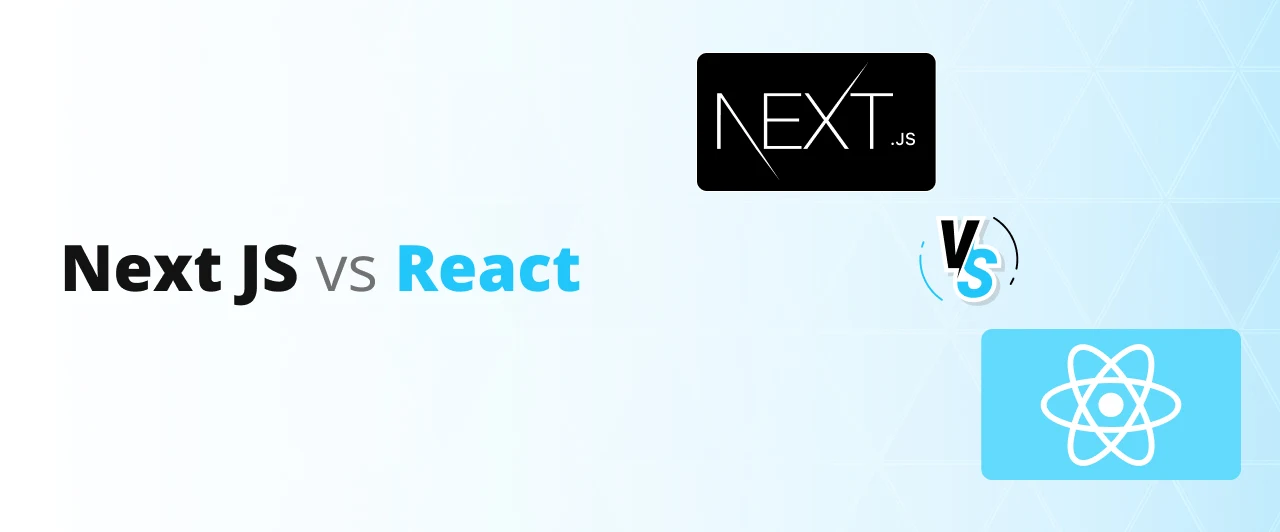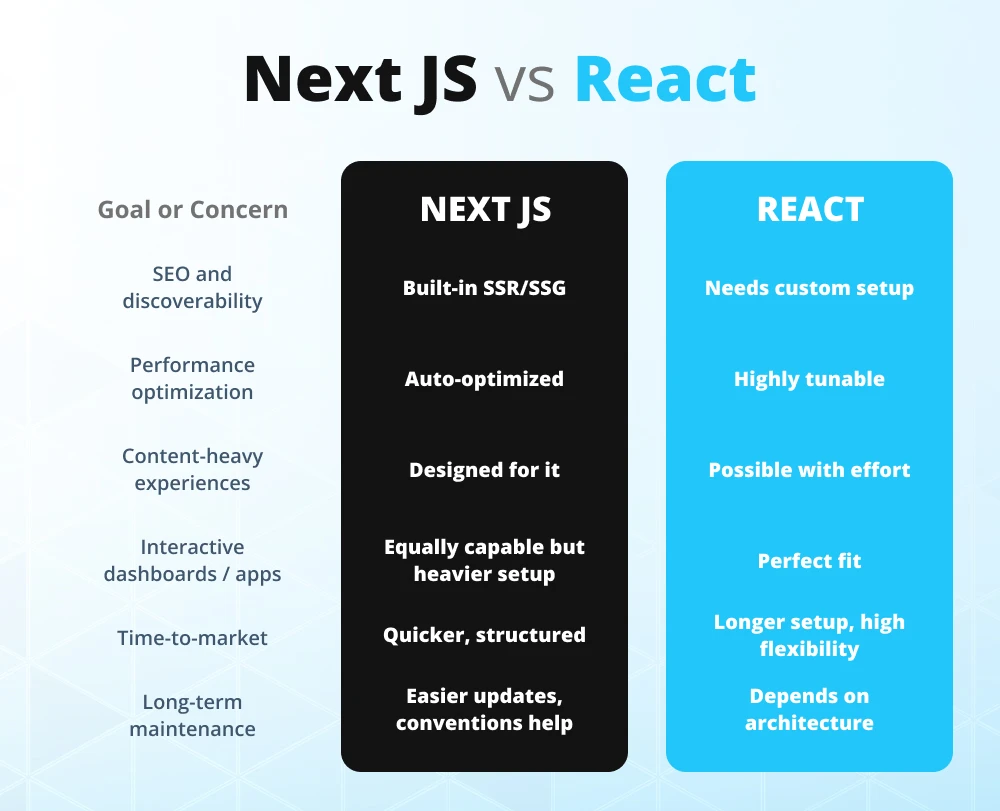



The web’s evolving faster than most teams can deploy.
AI is reshaping how users discover you. Core Web Vitals now decide who gets seen first. And the front end? It’s no longer about flashy UIs, it’s about speed, scalability, and staying future-proof.
That’s why the React vs Next.js debate keeps surfacing.
Everyone’s got a take, but the real question isn’t which one’s better, it’s which one’s right for what you’re building next.
React gave developers the freedom to create anything.
Next.js gave that freedom structure, performance, and SEO muscle.
One’s pure flexibility. The other’s precision engineering. Together, they shape most of the modern web but how you use them determines whether your product feels current or already catching up.
So before you lock in your stack, ask yourself:
Are you building for your next launch… or for the next five years?
In this guide, we’ll break down how React and Next.js fit into the 2026 front-end landscape, what’s changing in performance and search, and how the right React JS development company or Next JS development company can help you build smarter, not just faster.

React is the foundation of modern front-end development.
It’s a library, not a full framework, which means you decide how everything works: routing, state, data fetching, rendering.
That kind of freedom is why React runs so much of the web. You can build anything from dashboards, portals, single-page apps to hybrid products with unmatched precision.
But freedom takes time. You’ll often combine React with tools like React Router, Redux, or custom build setups. That’s perfect for teams who like owning every detail, but it can slow you down when SEO or content speed start to matter.
React makes sense when:
Learn More About React JS Development Service

Next.js was built to make React production-ready.
It keeps React at its core but adds the pieces businesses actually need: routing, SSR, SSG, API routes, and image optimization, all pre-wired.
That means better SEO, faster performance, and fewer deployment headaches from day one.
Next.js doesn’t lock you in; it just removes the setup pain.
Next.js makes sense when:
Users don’t wait, not even for two seconds. Google rewards sites that render fast and interact immediately.
Next.js handles this out of the box through server-side rendering and code splitting. React can match it, but it takes more manual tuning.
Search engines, including AI-powered results, now index based on rendered content.
Static or hybrid rendering in Next.js ensures pages are ready to crawl, no extra scripts or delays.
Your site doesn’t just live on one server anymore. Edge networks bring content closer to users.
Next.js integrates easily with Vercel or Netlify to make that happen. React alone can do it with more engineering effort.
Most mid- to large-scale products now use modular front-ends or micro-frontends. Both React and Next.js work here, but Next.js’s conventions reduce friction when multiple teams ship features simultaneously.
React Server Components and Next.js 14’s Turbopack bundler are rewriting what “fast” means in development.
Future-ready teams are already investing in these ecosystems for longevity along with performance.

If your product already runs on React, you’re not starting from scratch.
Next.js isn’t a different world; it’s the next step in the same one.
You don’t need to rebuild everything at once. Most teams move gradually, adding Next.js where it makes the most sense. That could mean migrating a few pages that rely on SEO, optimizing a slower section, or shifting entire modules once you see the performance gains. It’s a step-by-step evolution that keeps your current investment safe while setting up your front end for better visibility and smoother deployment.
The real difference isn’t in the framework you choose but in who helps you implement it.
A great partner doesn’t rush to replace what works. They help you figure out what actually needs to change and what doesn’t.
That’s the difference between a vendor and a development partner.
The right Next.js development company or React JS development company will:
When migration is handled thoughtfully, it doesn’t interrupt progress. It accelerates it.
It helps your product grow in the direction your business is already heading, without losing the foundation you’ve built.
React and Next.js aren’t rivals. They’re part of the same story, one that keeps evolving with how we build and experience the web.
React gives you control, flexibility, and the creative freedom to shape your own architecture. Next.js takes that same foundation and turns it into something faster, cleaner, and easier to maintain at scale.
Choosing between them isn’t about hype or features. It’s about clarity.
What are you optimizing for? Speed, SEO, maintainability, or developer freedom? The answer to that question should decide your stack, not a comparison chart or a trend post.
Both React and Next.js are here to stay. What will separate great digital products from good ones is how intentionally they’re built and how well their front ends adapt to what’s coming next.
If you’re thinking about rebuilding, modernizing, or scaling your app, take a step back and evaluate the “why” behind your stack. The right framework won’t just keep your app running, it’ll keep your business moving.

In this episode, we dive into the ongoing React vs Next.js debate and explore which framework best fits your front-end goals in 2026. From SEO and performance to scalability and team workflows, learn how to decide what truly drives your product’s success
What if the framework isn’t the real decision? What if it’s how you plan to grow with it?
Whether you’re scaling React or ready to move to Next.js, our front-end team can show you what’s possible when performance and strategy meet.
Let’s talk about what’s next for your product.
Are You Prepared for Digital Transformation?
eCommerce
Discover why top brands trust Angular for eCommerce. Fast, secure, and SEO ready, built by an expert AngularJS web development company delivering results.
Python Development
Discover why React and Python are the go-to stack for fast, scalable web apps. Build modern UIs with React and powerful backends with Python.
Java Development
Discover the 7 best Java frameworks for web app development. Build scalable, modern applications with tools like Spring Boot, Quarkus & more.